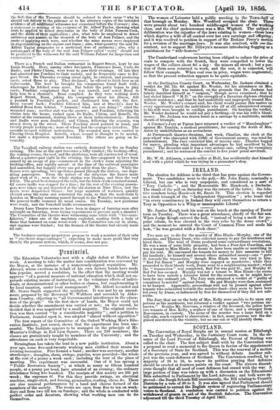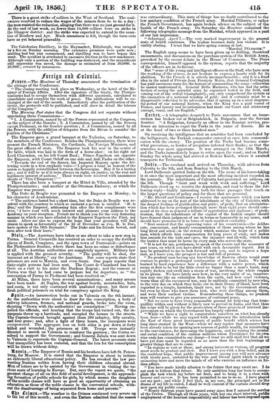SCOTLAND.
The Convention of Royal Burghs sat in annual P891011 at Edinburgh on Tuesday and Wednesday, in the Justiciary Court room. In the ab- sence of the Lord Provost of Edinburgh, the Provost of Stirling was called to the chair. The first subject dealt with by the tonvention was a proposal to send a memorial to the Queen in favour of the appointment of a Secretary of State for Scotland. This was the renewal of a motion of the previous year, and was agreed to without debate. Another sub- ject was the coast-defences of Scotland. The Convention resolved, by a majority of 29 to 16, to renew its petition praying that defences should be erected at fourteen points on the coast. The sixteen dissent- ients thought that all need of coast defences had ceased with the war. A large portion of time was taken up with a discussion on the Educational Rills submitted to Parliament by the Lord Advocate ; and both were ap- proved—the Burgh Schools Bill unanimously, the Bill relating to Country Districts by a vote of 30 to 9. It was also agreed that Parliament should be petitioned to extend the English system of registering Parliamentary voters to Scotland. A resolution was carried to petition against the withdrawal of grants in aid of the Scottish fisheries. The ConveutiOfl adjourned till the third Tuesday of April 1857. There is a great strike of colliers in the West of Scotland. The coal- owners resolved to reduee the wages of the miners from bs. to 4s. a day : thetMente4listed the reduction, alleging that there was no just ground font. At the end of last week, no fewer than 14,000 colliers were on strike in the Glasgow district : and the strike was expected to extend to the coun- ties of Renfrew and Ayr. Much uneasiness is felt, though the turn-outs have as yet behaved peaceably.
The Caledonian Distillery, in the Haymarket, Edinburgh, was ravaged by a fire on Sunday monimg. The extensive premises were quite new • malting had but just commenced, and distilling war to have begun this week. The accident is attributed to excessive friction in the new machinery. Although only a portion of the building was destroyed, and the magnificent still apparatus was saved, the damage is estimated at from 20,0001. to 30,000/., covered by insurances.



























 Previous page
Previous page